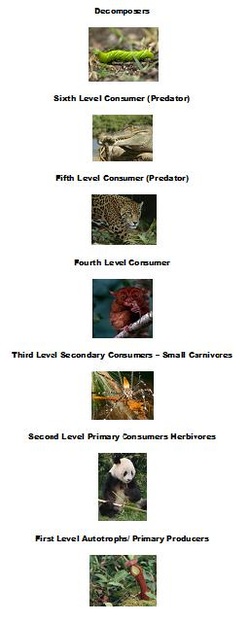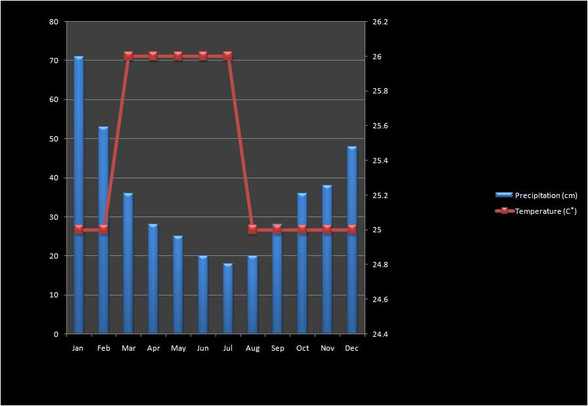General Information on Borneo

Biome: Tropical Rainforest
A biome is a large geographical area that share similar climatic conditions and therefore, gives rise to similar vegetation patterns. Examples include the cold desert, artic tundra, and tropical rainforest. The Borneo rainforest is a tropical rainforest located in Asia. Tropical rainforests, in general, are located within the area 5 degrees North and South of the equator. There are amazingly high levels of biodiversity in both tropical rainforests and the Borneo. Competition between plants for light creates a multi-storey profile in the forest. This stratification of plant species creates a multitude of niches and habitats for animals.
Location
The Borneo rainforest covers an island of three countries located in Southeast Asia. The countries are Malaysia (the states of Sabah and Sarawak) which houses 26.7% of the forest, Brunei which houses 0.6%, and Indonesia (the territory of Kalimantan split into West, Central, South, and East) which houses 72.6%. The island as a whole is generally referred to as Kalimantan. The island is the third largest in the world with an area of 743,330 square kilometers and has one extinct volcano and the highest mountain range in Southeast Asia, Mount Kinabalu.
Climate
The island enjoys warm, sunny tropical conditions with occasional cool breezes from the sea. Temperatures range from 30-35 degrees Celsius during the day and 26-29 degrees Celsius at night. There is little seasonal variation. However, the close distance to the equator results in high humidity and rainfall throughout the year.
It is always raining in Borneo! In fact, the heaviest rain happens during the monsoon season between October and March. As a result of high rainfall, nutrients are washed out of the soil which may limit plant growth. Sunlight is another prominent limiting factor because the fastest-growing trees create a canopy over the rainforest under which grows a second layer of trees with less light. Nearly all the sunlight is intercepted before it can reach the forest floor.
A biome is a large geographical area that share similar climatic conditions and therefore, gives rise to similar vegetation patterns. Examples include the cold desert, artic tundra, and tropical rainforest. The Borneo rainforest is a tropical rainforest located in Asia. Tropical rainforests, in general, are located within the area 5 degrees North and South of the equator. There are amazingly high levels of biodiversity in both tropical rainforests and the Borneo. Competition between plants for light creates a multi-storey profile in the forest. This stratification of plant species creates a multitude of niches and habitats for animals.
Location
The Borneo rainforest covers an island of three countries located in Southeast Asia. The countries are Malaysia (the states of Sabah and Sarawak) which houses 26.7% of the forest, Brunei which houses 0.6%, and Indonesia (the territory of Kalimantan split into West, Central, South, and East) which houses 72.6%. The island as a whole is generally referred to as Kalimantan. The island is the third largest in the world with an area of 743,330 square kilometers and has one extinct volcano and the highest mountain range in Southeast Asia, Mount Kinabalu.
Climate
The island enjoys warm, sunny tropical conditions with occasional cool breezes from the sea. Temperatures range from 30-35 degrees Celsius during the day and 26-29 degrees Celsius at night. There is little seasonal variation. However, the close distance to the equator results in high humidity and rainfall throughout the year.
It is always raining in Borneo! In fact, the heaviest rain happens during the monsoon season between October and March. As a result of high rainfall, nutrients are washed out of the soil which may limit plant growth. Sunlight is another prominent limiting factor because the fastest-growing trees create a canopy over the rainforest under which grows a second layer of trees with less light. Nearly all the sunlight is intercepted before it can reach the forest floor.
Species and Biodiversity

The Borneo is one of the most biodiverse forests on earth with at least 222 different species of mammals (44 of which are endemic), 420 species of birds (37 of which are endemic), 100 amphibians, 394 fish (19 of which are endemic), and 15,000 plants (6,000 of which are endemic).
This ecosystem is home to over 15,000 different species of plants, making producers the most profuse organisms. Producers include the Bengal Bamboo (Bambusa tulda) which often grows as a scattered undergrowth, the Durian Tree which grows to heights of over 90 feet and lives for over 80 years, the Jambu Ayer, the Kapok Tree which provides a home for plants dependent on sunlight, Mangrove Forests, Strangler Figs, and the Tualang Tree. These organisms are responsible for converting sunlight in chemical energy that they can use. They provide food, and therefore energy, and oxygen for consumers.
This tropical rainforest also provides homes for a vast number of consumers including the clouded leopard, sun bear, Bengal Tiger, Musang, Dawn Bat, Jambu Fruit Dove, King Cobra, Orangutan, and Silvery Gibbon among many others. The Jambu Fruit Dove and Red-Shanked Douc Langur are herbivores, eating only producers. The Musang, Orangutan, and Wagler's Pit Viper are carnivores, eating both plants and animals alike. Examples of the top carnivores in the Borneo are the Bengal Tiger, King Cobra, clouded leopard, and sun bear; these animals are at the top of the food chain and consume most that exist below it. Consumers get their energy from producers and fulfill a niche in the Borneo rainforest. Without them, the Borneo would lose a substantial amount of biodiversity and simply be a mass of thick vegetation. They create a balance and are another source to which energy travels to and through.
Detrivores, or decomposers, feed on decayed organisms and are key in returning nutrients back to the soil. They break down complex organic molecules into simpler forms. Decomposers in the Borneo include fungi (mycorrhizae), bacteria, viruses, slugs, and snails.
Trophic levels refer to the feeding position that an organism occupies in the food chain of an ecosystem. Producers form the first trophic level, herbivores the second, and carnivores the third, fourth, fifth, and occasionally sixth.
This ecosystem is home to over 15,000 different species of plants, making producers the most profuse organisms. Producers include the Bengal Bamboo (Bambusa tulda) which often grows as a scattered undergrowth, the Durian Tree which grows to heights of over 90 feet and lives for over 80 years, the Jambu Ayer, the Kapok Tree which provides a home for plants dependent on sunlight, Mangrove Forests, Strangler Figs, and the Tualang Tree. These organisms are responsible for converting sunlight in chemical energy that they can use. They provide food, and therefore energy, and oxygen for consumers.
This tropical rainforest also provides homes for a vast number of consumers including the clouded leopard, sun bear, Bengal Tiger, Musang, Dawn Bat, Jambu Fruit Dove, King Cobra, Orangutan, and Silvery Gibbon among many others. The Jambu Fruit Dove and Red-Shanked Douc Langur are herbivores, eating only producers. The Musang, Orangutan, and Wagler's Pit Viper are carnivores, eating both plants and animals alike. Examples of the top carnivores in the Borneo are the Bengal Tiger, King Cobra, clouded leopard, and sun bear; these animals are at the top of the food chain and consume most that exist below it. Consumers get their energy from producers and fulfill a niche in the Borneo rainforest. Without them, the Borneo would lose a substantial amount of biodiversity and simply be a mass of thick vegetation. They create a balance and are another source to which energy travels to and through.
Detrivores, or decomposers, feed on decayed organisms and are key in returning nutrients back to the soil. They break down complex organic molecules into simpler forms. Decomposers in the Borneo include fungi (mycorrhizae), bacteria, viruses, slugs, and snails.
Trophic levels refer to the feeding position that an organism occupies in the food chain of an ecosystem. Producers form the first trophic level, herbivores the second, and carnivores the third, fourth, fifth, and occasionally sixth.
Different Levels and Soil Composition
The five layers are Emergent, Canopy, Middle Layer, Shrub Layer, and the Herb Layer. Because of the amount of different layers in the rainforest, most of the time, all of the forest floor is completely shaded. Because of this, not many small herbs and shrubs can grow, the top soil is actually quite thin and of very low quality. Most people think that rainforest soil is very fertile because of the diverse amounts of plants it supports, but it is actually the opposite. Because even when nutrients do fall to the floor, they are decomposed by decomposers such as worms and fungi. The soil overall is very wet due to the amount of rain, very shallow, and lacking of minerals. As a result, plants (to adapt) have shallow roots in addition to buttress roots for support because most nutrients are near the surface.
Productivity
Primary productivity is the rate at which producers, generally plants, accumulate energy while secondary productivity is the rate at which consumers (herbivores, carnivores, and detrivores) convert the chemical energy available in food into their biomass.
The term gross productivity, or GP, is the total gain in energy or biomass per unit area per unit time. However, it is imperative that organisms respire which deducts from this total. The net productivity (NP) is the gain in energy or biomass per unit area per unit time that remains after energy is utilized.
The gross primary productivity (GPP) refers to the total amount of energy fixed by plants during photosynthesis. It is essentially the rate at which an ecosystem's producers capture energy and store it as chemical energy. The tropical rainforest is a very valuable and high-yielding biome with a GPP of 20,000 kcal/m^2/year (the amount of energy produced in kilocalories in a square meter of surface area per year), ranking with coral reefs and estuaries as the most productive natural ecosystem on earth. The net primary productivity (NPP) is the net amount of primary production after the costs of plant respiration are considered. NPP = GPP - R (respiration). Tropical rainforests are estimated to produce 40% of the total NPP of terrestrial ecosystems.
Fun Facts!
1. Over 16 million people live in Borneo.
2. Borneo is home to many endangered organisms such as the orangutan, Asian elephant, proboscis monkey, flying frog, and many species of plants.
3. Although, the most famous animal in the Borneo rainforest is the Orangutan, they are known as the “old man of the forest” and 90 percent of the world’s orangutans live in Borneo. But sadly, they are highly endangered.
1. Over 16 million people live in Borneo.
2. Borneo is home to many endangered organisms such as the orangutan, Asian elephant, proboscis monkey, flying frog, and many species of plants.
3. Although, the most famous animal in the Borneo rainforest is the Orangutan, they are known as the “old man of the forest” and 90 percent of the world’s orangutans live in Borneo. But sadly, they are highly endangered.

